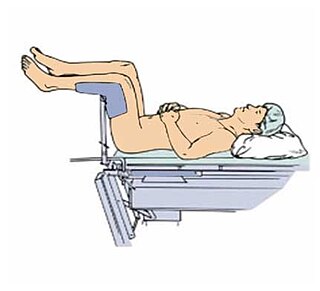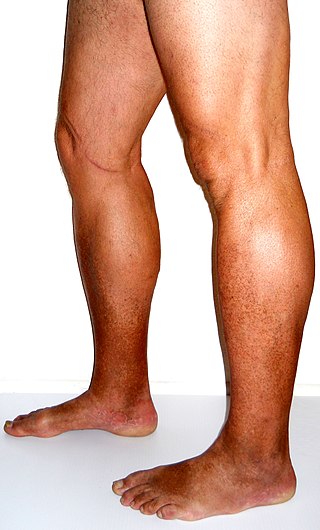
In human anatomy, a hamstring is any one of the three posterior thigh muscles between the hip and the knee.

The lithotomy position is a common position for surgical procedures and medical examinations involving the pelvis and lower abdomen, as well as a common position for childbirth in Western nations. The lithotomy position involves the positioning of an individual's feet above or at the same level as the hips, with the perineum positioned at the edge of an examination table. References to the position have been found in some of the oldest known medical documents including versions of the Hippocratic oath ; the position is named after the ancient surgical procedure for removing kidney stones and bladder stones via the perineum. The position is perhaps most recognizable as the 'often used' position for childbirth: the patient is laid on the back with knees bent, positioned above the hips, and spread apart through the use of stirrups.

Coxa vara is a deformity of the hip, whereby the angle between the head and the shaft of the femur is reduced to less than 120 degrees. This results in the leg being shortened and the development of a limp. It may be congenital and is commonly caused by injury, such as a fracture. It can also occur when the bone tissue in the neck of the femur is softer than normal, causing it to bend under the weight of the body. This may either be congenital or the result of a bone disorder. The most common cause of coxa vara is either congenital or developmental. Other common causes include metabolic bone diseases, post-Perthes deformity, osteomyelitis, and post traumatic. Shepherd's Crook deformity is a severe form of coxa vara where the proximal femur is severely deformed with a reduction in the neck shaft angle beyond 90 degrees. It is most commonly a sequela of osteogenesis imperfecta, Paget's disease, osteomyelitis, tumour and tumour-like conditions.

The gluteus minimus, or glutæus minimus, the smallest of the three gluteal muscles, is situated immediately beneath the gluteus medius.

Spondylosis is the degeneration of the vertebral column from any cause. In the more narrow sense it refers to spinal osteoarthritis, the age-related degeneration of the spinal column, which is the most common cause of spondylosis. The degenerative process in osteoarthritis chiefly affects the vertebral bodies, the neural foramina and the facet joints. If severe, it may cause pressure on the spinal cord or nerve roots with subsequent sensory or motor disturbances, such as pain, paresthesia, imbalance, and muscle weakness in the limbs.

Friedrich Trendelenburg was a German surgeon. He was son of the philosopher Friedrich Adolf Trendelenburg, father of the pharmacologist Paul Trendelenburg and grandfather of the pharmacologist Ullrich Georg Trendelenburg.

In the Trendelenburg position, the body is lain supine, or flat on the back on a 15–30 degree incline with the feet elevated above the head. The reverse Trendelenburg position, similarly, places the body supine on an incline but with the head now being elevated.

Lithotomy from Greek for "lithos" (stone) and "tomos" (cut), is a surgical method for removal of calculi, stones formed inside certain organs, such as the urinary tract, bladder, and gallbladder (gallstones), that cannot exit naturally through the urinary system or biliary tract. The procedure is usually performed by means of a surgical incision. Lithotomy differs from lithotripsy, where the stones are crushed either by a minimally invasive probe inserted through the exit canal, or by an acoustic pulse, which is a non-invasive procedure. Because of these less invasive procedures, the use of lithotomy has decreased significantly in the modern era.

Trendelenburg's sign is found in people with weak or paralyzed abductor muscles of the hip, namely gluteus medius and gluteus minimus. It is named after the German surgeon Friedrich Trendelenburg. It is often incorrectly referenced as the Trendelenburg test which is a test for vascular insufficiency in the lower extremities.

A hip dislocation is when the thighbone (femur) separates from the hip bone (pelvis). Specifically it is when the ball–shaped head of the femur separates from its cup–shaped socket in the hip bone, known as the acetabulum. The joint of the femur and pelvis is very stable, secured by both bony and soft-tissue constraints. With that, dislocation would require significant force which typically results from significant trauma such as from a motor vehicle collision or from a fall from elevation. Hip dislocations can also occur following a hip replacement or from a developmental abnormality known as hip dysplasia.
Trendelenburg gait, named after Friedrich Trendelenburg, is an abnormal gait. It is caused by weakness or ineffective action of the gluteus medius muscle and the gluteus minimus muscle.
In medicine, physiotherapy, chiropractic, and osteopathy the hip examination, or hip exam, is undertaken when a patient has a complaint of hip pain and/or signs and/or symptoms suggestive of hip joint pathology. It is a physical examination maneuver.

Neurogenic claudication (NC), also known as pseudoclaudication, is the most common symptom of lumbar spinal stenosis (LSS) and describes intermittent leg pain from impingement of the nerves emanating from the spinal cord. Neurogenic means that the problem originates within the nervous system. Claudication, from the Latin word for to limp, refers to painful cramping or weakness in the legs. NC should therefore be distinguished from vascular claudication, which stems from a circulatory problem rather than a neural one.

Chronic venous insufficiency (CVI) is a medical condition in which blood pools in the veins, straining the walls of the vein. The most common cause of CVI is superficial venous reflux which is a treatable condition. As functional venous valves are required to provide for efficient blood return from the lower extremities, this condition typically affects the legs. If the impaired vein function causes significant symptoms, such as swelling and ulcer formation, it is referred to as chronic venous disease. It is sometimes called chronic peripheral venous insufficiency and should not be confused with post-thrombotic syndrome in which the deep veins have been damaged by previous deep vein thrombosis.
The Trendelenburg Test or Brodie–Trendelenburg test is a test which can be carried out as part of a physical examination to determine the competency of the valves in the superficial and deep veins of the legs in patients with varicose veins.

Pigeon toe, also known as in-toeing, is a condition which causes the toes to point inward when walking. It is most common in infants and children under two years of age and, when not the result of simple muscle weakness, normally arises from underlying conditions, such as a twisted shin bone or an excessive anteversion resulting in the twisting of the thigh bone when the front part of a person's foot is turned in.

An operating table, sometimes called operating room table, is the table on which the patient lies during a surgical operation. This surgical equipment is usually found inside the surgery room of a hospital. A specialized type of operating table is call a surgical fracture table is designed to allow an orthopedic surgeon to perform common orthopedic procedures such as hip fractures, pelvic fractures, tibial fractures, fibula fractures, and anterior approach total hip arthroplasty. Modern surgical fracture tables cost >US$200,000, but the costs can be reduced to make them more accessible using distributed digital fabrication with 3D printing of open-source hardware designs.
Surgical positioning is the practice of placing a patient in a particular physical position during surgery. The goal in selecting and adjusting a particular surgical position is to maintain the patient's safety while allowing access to the surgical site. Often a patient must be placed in an unnatural position to gain access to the surgical site.
Bone malrotation refers to the situation that results when a bone heals out of rotational alignment from another bone, or part of bone. It often occurs as the result of a surgical complication after a fracture where intramedullary nailing (IMN) occurs, especially in the femur and tibial bones, but can also occur genetically at birth. The severity of this complication is often neglected due to its complexity to detect and treat, yet if left untreated, bone malrotation can significantly impact regular bodily functioning, and even lead to severe arthritis. Detection throughout history has become more advanced and accurate, ranging from clinical assessment to ultrasounds to CT scans. Treatment can include an osteotomy, a major surgical procedure where bones are cut and realigned correctly, or compensatory methods, where individuals learn to externally or internally rotate their limb to compensate for the rotation. Further research is currently being examined in this area to reduce occurrences of malrotation, including detailed computer navigation to improve visual accuracy during surgery.












